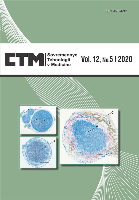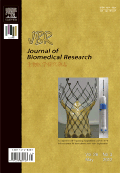
Sovremennye Tehnologii v Medicine
Scope & Guideline
Empowering Medical Professionals with Contemporary Insights
Introduction
Aims and Scopes
- Medical Imaging and Diagnostics:
The journal publishes studies on various imaging techniques, including Optical Coherence Tomography, MRI, and radiomics, aimed at enhancing diagnostic accuracy and treatment planning. - Artificial Intelligence in Medicine:
A significant focus on the application of AI and machine learning in healthcare, particularly in predictive analytics, diagnostic algorithms, and treatment personalization. - Tissue Engineering and Regenerative Medicine:
Research on innovative biomaterials, scaffolds, and cellular therapies to promote tissue regeneration and repair, often incorporating novel methodologies. - Genomics and Molecular Biology:
Exploration of genetic markers, molecular pathways, and their implications in disease mechanisms, particularly in cancer and genetic disorders. - Neuroscience and Neurotechnology:
Studies related to neurological conditions, brain-computer interfaces, and neurorehabilitation technologies, highlighting advancements in understanding brain function and recovery. - Surgical Innovations and Techniques:
Research on minimally invasive surgical techniques, novel surgical protocols, and their outcomes, focusing on improving patient safety and recovery.
Trending and Emerging
- Telemedicine and Remote Monitoring:
There is an increasing emphasis on telemedicine and remote patient monitoring technologies, particularly in response to the COVID-19 pandemic, highlighting their importance in modern healthcare delivery. - Personalized Medicine and Genomics:
A trend towards personalized medicine, with a focus on genomic data and tailored therapies, is evident, reflecting a broader shift in healthcare towards individualized treatment plans. - Biomaterials and Bioengineering:
Research on novel biomaterials for various applications in regenerative medicine and surgical procedures is on the rise, driven by innovations in material science. - Neurotechnology and Brain-Machine Interfaces:
The field of neurotechnology, particularly brain-computer interfaces for rehabilitation and treatment of neurological disorders, is gaining traction, signaling a robust interest in integrating technology with neuroscience. - AI and Machine Learning Applications:
The utilization of AI and machine learning in diagnostics, treatment planning, and predictive analytics is rapidly increasing, showcasing their transformative potential in clinical practice.
Declining or Waning
- Traditional Surgical Techniques:
There has been a noticeable decline in publications focusing on conventional surgical methods, as the field moves towards minimally invasive and technologically advanced approaches. - Basic Biomedical Research:
Research emphasizing basic science without direct clinical applications has decreased, indicating a shift towards translational research that directly impacts patient care. - Invasive Diagnostic Procedures:
The frequency of studies on invasive diagnostic techniques appears to be waning as non-invasive and imaging-based methods gain favor due to their safety and effectiveness.
Similar Journals

Biomedical Engineering Online
Empowering research at the intersection of engineering and medicine.Biomedical Engineering Online, published by BMC, is an esteemed open-access journal in the United Kingdom that has been advancing the field of biomedical engineering since its inception in 2002. With a commitment to disseminating high-quality research, the journal encompasses a broad scope, including innovative studies in biomaterials, imaging technologies, and medical applications. Recognized within the Q2 quartile for various categories such as Biomaterials and Biomedical Engineering, it ranks favorably among its peers: Rank #58 out of 333 in Radiology, and Rank #15 out of 63 in Radiological and Ultrasound Technology in the Scopus database. These rankings, coupled with an open-access model, ensure that critical advancements in medical technology are accessible to researchers, health professionals, and students globally. As it continues through its converged years from 2002 to 2024, Biomedical Engineering Online remains an invaluable resource for anyone involved in the cutting-edge intersection of engineering and medicine.

Advanced Biomedical Research
Connecting Minds, Shaping the Future of MedicineAdvanced Biomedical Research, published by Wolters Kluwer Medknow Publications, is a prominent open access journal dedicated to advancing the field of biomedical research since its inception in 2012. With an ISSN of 2277-9175, this journal serves as a vital platform for researchers, professionals, and students to disseminate high-quality research findings and innovative ideas in a variety of topics within biochemistry, genetics, and molecular biology. Recognized within the Q3 category of the 2023 journal quartile rankings, it ranks 365th among general medicine journals and 187th in the general fields of biochemistry and genetics, underscoring its commitment to fostering scientific dialogue and collaboration. With its open access model, Advanced Biomedical Research ensures that research is readily accessible to a global audience, thereby enhancing the visibility and impact of scholarly work. As the journal continues to evolve through its converged editorial focus from 2019 to 2024, it aims to play a critical role in shaping the future of biomedical sciences in India and beyond.

Plastic and Reconstructive Surgery-Global Open
Pioneering discoveries in plastic surgery, globally.Plastic and Reconstructive Surgery-Global Open is a premier open-access journal dedicated to advancing the field of plastic and reconstructive surgery. Published by LIPPINCOTT WILLIAMS & WILKINS, this influential journal, with an ISSN of 2169-7574, began its journey in 2013 and has since contributed significantly to scholarly discourse, achieving a notable Q2 rank in Surgery as per 2023's category quartiles. With its base in the United States, the journal is committed to making high-quality research freely accessible, which fosters collaboration and knowledge sharing among researchers, practitioners, and students worldwide. The journal encompasses a wide range of topics, ensuring it remains at the forefront of innovations and techniques in the field. Its impact factor reflects its importance in shaping surgical standards and practices, and it continues to be a vital resource for those dedicated to improving patient care through advanced surgical solutions. Access to cutting-edge research and developments is guaranteed as the journal is open-access, allowing an extensive audience to engage with the latest findings.

Advanced Biology
Pioneering Innovations in Life SciencesAdvanced Biology, published by WILEY-V C H VERLAG GMBH, serves as a premier platform where innovative research and scientific breakthroughs in the fields of biochemistry, genetics, and molecular biology converge. Established in 2021, this journal has rapidly ascended to prominence, securing Q1 rankings in its primary categories, including general biochemistry and biomedical engineering, and a solid Q2 ranking in biomaterials. With an ISSN of 2701-0198 and an emphasis on open access, Advanced Biology ensures that rigorous peer-reviewed research is accessible to a global audience, enhancing visibility and fostering collaboration among researchers, professionals, and students alike. By 2024, it aims to continually elevate scientific understanding and innovation, catering to the growing interdisciplinary nature of these critical fields. With Scopus rankings placing it amongst the top quartiles in its disciplines, Advanced Biology is poised to make significant contributions to the future of life sciences.

Cold Spring Harbor Molecular Case Studies
Unveiling the complexities of molecular case studies.Cold Spring Harbor Molecular Case Studies is a prestigious journal published by COLD SPRING HARBOR LAB PRESS, PUBLICATIONS DEPT, that has garnered considerable attention in the fields of Biochemistry, Genetics, and Molecular Medicine. With a focus on the intersection of molecular biology and clinical case studies, this journal serves as a key resource for researchers and practitioners seeking to explore novel insights into genetic disorders and biomedical advances. Its impact is underscored by its categorization in Q2 in various disciplines in 2023, reflecting its significance and influence within the academic community. Although currently not labeled as Open Access, Cold Spring Harbor Molecular Case Studies provides a rigorous platform for disseminating high-quality, peer-reviewed research that drives innovation and enhances understanding in these rapidly evolving fields. As a supporter of advancing scientific knowledge, this journal is essential for those dedicated to the exploration of molecular mechanisms and their clinical implications.

Biomedical Engineering Letters
Connecting scholars to elevate biomedical engineering.Biomedical Engineering Letters, published by SpringerNature, is a prominent journal in the field of Biomedical Engineering. With a robust ISSN of 2093-9868 and E-ISSN of 2093-985X, this esteemed journal has established itself as a vital resource for researchers and professionals seeking to advance their knowledge and share groundbreaking findings. Recognized for its quality, Biomedical Engineering Letters holds a distinguished ranking in Scopus, positioned at #94/303 (69th percentile) in the Biomedical Engineering category. The journal covers a diverse scope within biomedical engineering, providing an important platform for innovative research from 2011 to 2024 and facilitating the exchange of ideas among scholars. Although it operates under a subscription model, the journal's commitment to enhancing the field makes it an indispensable reference for those engaged in cutting-edge biomedical research in Germany and globally.

BME Frontiers
Exploring the Future of Biomedical EngineeringBME Frontiers, published by the American Association for the Advancement of Science, is an innovative open-access journal dedicated to the burgeoning field of Biomedical Engineering. Since its establishment in 2020, this journal has aimed to bridge the gap between cutting-edge research and practical application, promoting advancements in biomedical technologies, medical devices, and healthcare solutions. Boasting impressive rankings within Scopus—64th among 398 in Medicine (miscellaneous) and 81st among 303 in Biomedical Engineering—BME Frontiers stands out as a significant contributor to scholarly communication, offering rich insights for researchers, professionals, and students alike. With consistent publication projected through 2024, the journal serves as an essential platform for disseminating high-quality research that can drive innovation and inspire new approaches in the healthcare sector.

JOR Spine
Driving excellence in spine care through open access.JOR Spine is a premier open access journal published by WILEY, focusing on advancing the field of orthopedics and sports medicine. With its ISSN 2572-1143 and E-ISSN 2572-1143, the journal has rapidly gained recognition since its inception in 2018, reflecting the high-quality research being disseminated within the academic community. It holds an impressive rank of #41 out of 321 in the Scopus classification for Medicine, specifically within Orthopedics and Sports Medicine, placing it in the 87th percentile—an indicator of its substantial contribution to the field. As a Q1 journal in its category as of 2023, JOR Spine is committed to publishing rigorous research that enhances clinical practice and informs future studies. The journal’s open access model ensures that critical findings are accessible to a global audience of researchers, practitioners, and students, fostering collaboration and innovation in spine research. With regular issues and an array of article types reflecting contemporary advancements, JOR Spine serves as an essential resource for anyone involved in the spine care continuum.

Journal of Biomedical Research
Elevating Biomedical Research Through Rigorous ScholarshipJournal of Biomedical Research, published by Nanjing Medical University in China, is a prominent platform for groundbreaking discoveries in the fields of Biochemistry, Genetics, and Molecular Biology, as well as Medicine. With an ISSN of 1674-8301 and an E-ISSN of 1876-4819, the journal offers a vital opportunity for researchers, professionals, and students to disseminate insightful research findings. Although not currently available as an open access journal, its inclusion in the second quartile of both Biochemistry and Medicine categories underscores its growing influence and commitment to high-quality scholarship, as evidenced by its historical compliance with Scopus rankings prior to 2009. By fostering an interdisciplinary approach, the Journal of Biomedical Research aims to bridge gaps in current biomedical understanding and encourages innovative research that can lead to significant contributions in improving health outcomes. Its editorial policies guarantee rigorous peer review, making it a trusted source of knowledge in the biomedical community.

KEIO JOURNAL OF MEDICINE
Elevating Standards in Medical ResearchKEIO JOURNAL OF MEDICINE, published by the Keio University in Japan, is an esteemed medical journal that has been a cornerstone of medical research since its inception in 1952. With an ISSN of 0022-9717 and an E-ISSN of 1880-1293, this journal plays a crucial role in disseminating valuable research across various disciplines within the field of medicine. Currently ranking in the Q3 quartile in the category of Medicine (miscellaneous) and holding a commendable Scopus Ranks of #168 out of 636 publishers, it stands in the 73rd percentile, highlighting its growing impact in the academic community. The journal's commitment to enhancing medical knowledge is evident through its rigorous peer-review process, aiming to provide high-quality content that appeals to researchers, practitioners, and students alike. Although the journal operates under a subscription model, it remains a vital resource for those invested in advancing the field of medicine, addressing contemporary challenges, and exploring innovations in medical practice.